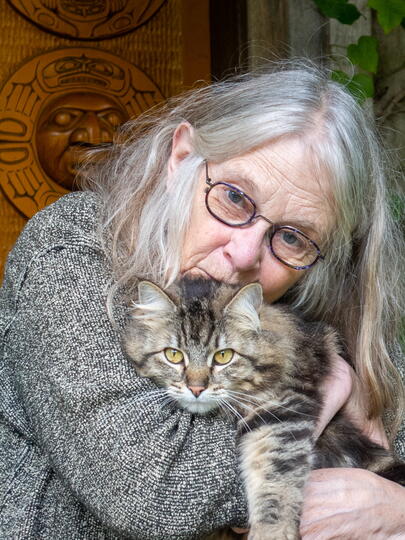Kip the coyote calls UBC Vancouver campus home
Thanks to COVID-19, UBC’s Vancouver campus is seeing fewer students, faculty and staff than normal these days, but there is a new, furry community member who has taken up residence.
It has three functional legs, a taste for squirrels and voles and has been seen by more than a few curious onlookers and cameras. But according to experts, it’s best not to say hello.
In fact, the best advice if you see Kip the coyote is to yell at it, says Dr. Kristen Walker, researcher and tenure-track instructor in the faculty of land and food systems.
“Based on reports of this coyotes’ behaviour, it keeps its distance from people and does not show habituation or dependence on humans. To maintain this healthy boundary, community members are asked to ‘haze’ this or other coyotes when seen — persistently, consistently, and humanely. Hazing means scaring it by standing one’s ground, raising one’s arms to look big, and making lots of noise, leaving a clear escape route for it to leave,” says Dr. Walker.
“You may also throw nearby objects like sticks or stones towards them (not to hit), pop open an umbrella, or shake a noisemaker like an empty pop can filled with rocks. The key is to look and sound big and threatening.”
Kip was born in early 2020 somewhere in the vicinity of the campus. Since then, the juvenile (whose sex is not yet known) has suffered an injury to its back right leg. The injury was first witnessed on trail camera footage in November 2020.
Various wildlife veterinarians, a wildlife rescue organization, the Conservation Officers Service, as well as the Co-existing with Coyotes program through the Stanley Park Ecology Society have been consulted regarding Kip’s injury and the animals’ progress. Walker and her students are also watching Kip very closely.
The prognosis, Walker notes, is good, as long as the campus community follows basic guidelines and leaves Kip (and the roughly dozen other coyotes on the Vancouver campus) alone.
“The consensus is to let the animal be and monitor (through trail camera footage or incidental sightings). The coyote is highly mobile, has been seen actively hunting (squirrels and voles) and capturing prey on dozens of occasions, and is in overall good body condition. Kip is also occasionally seen with other members from its pack,” she says.

Reports of Kip have come in from across campus. Given the coyotes’ range, Walker says it’s crucial the campus community and area residents follow some basic rules and guidance to ensure not only their safety, but that of the coyotes.
Walker and the Stanley Park Ecology Centre’s advice also applies at UBC Okanagan where coyotes are not uncommon:
- Most important is that this coyote does not receive food from people. It has been hunting natural prey self-sufficiently and does not require human handouts for its survival. On the contrary, feeding this coyote (whether directly or indirectly) can cause a dependence on humans that will put it and people at risk. This practice can be detrimental to the coyote over the long-term.
- Coyotes are highly agile and cautious. Injured coyotes do not mean aggressive coyotes. For their own protection, they will want to avoid dangers and find sustenance away from potential threats, such as humans or dogs.
- Pet owners must keep their dogs or cats on-leash when outside, especially in green or forested spaces. Off-leash dogs are a threat to an injured coyote, as dogs may not stop their approach and a coyote will defend itself, if forced.
- The coyote should not be approached by anyone in the public, even if immobile. If approached, the coyote may feel the need to defend itself, which may cause harm. While we would like to give this coyote its best chance at recovery, coyotes often live for a long time with an injury, and must be respected as wild animals.
- Assessment of possible attractants such as open garbage/compost is also important, so that the coyote does not learn to depend on easier food sources while it is injured. This lessens its attraction to places that bring it closer to people, and the chance that it will depend on these food sources.
If you see Kip, please report your sighting to Dr. Kristen Walker at ubcwildlifesightings@gmail.com, so she and her students can monitor its condition and location.
For more information about coyotes in the urban environment, visit the Stanley Park Ecology Society.

































